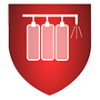RES can organise and co-ordinate servicing, maintenance, refilling, design and installation of all types of fixed fire-fighting systems permanently installed in buildings for the purpose of controlling, suppressing or extinguishing fires, by either automatic or manual discharge of a fire extinguishing medium.
FIRE EXTINGUISHING SYSTEMS

Our Fire Extinguishing Systems Services
Design and Installation
Servicing
Maintenance
Refilling
Gaseous Fixed Fire Extinguishing Systems
Generally two types of gaseous fixed fire extinguishing systems are available for normally manned enclosures:
• Oxygen reduction systems that use inert gases such as Argon, CO2, Nitrogen or a combination
• Gaseous clean agent systems that cool and breakdown the chemical reactions in fire
Oxygen reduction systems aim to prevent a fire occurring in a protected area. The oxygen level would usually be reduced to below 15Vol % content (normal air contains 20.9Vol %) but different oxygen levels are used for different applications. These systems are normally used in IT server rooms, archive storage areas, warehouse or cold stores, and laboratories. These areas are normally unmanned but entry for short periods, up to about 4 hours, will be possible.
Clean agent systems include gases such as FM200, Novec 1230, Halotran HB, NAF SHFC125 and FE13. Due to environmental issues, these gaseous clean agent systems have replaced halon 1301 as an extinguishing agent. Gaseous extinguishing systems should be installed by companies certified to LPS1204 third party certification schemes, which prove their competence in that area.
Gaseous clean agent fire extinguishing systems are used for computer rooms and EDP; indoor transformers and switchgear; telecommunications, generators; engine and turbine enclosures, and flammable liquid stores. CO2 systems are used for areas where, electrical hazards, flammable or combustible materials may be present but which are not normally occupied.
Typical applications include turbines, machinery, silos switchgear and similar electrical hazards. Generally gaseous fire protection systems are operated by specific automatic fire detection systems in which detector provision and spacing is configured to give very early detection. Usually a “double knock” activation of two detector heads is necessary to discharge the gas. A warning is normally given in the protected area before the gas discharges to allow personnel to leave the area.
Other Fixed Fire Extinguishing Systems
Foam and powder are two other fixed extinguishing systems that are available and will suit certain applications. Foam systems are used for areas where flammable liquids and/or plastics are handled and stored. Foam forms a blanket over the surface of flammable liquids to extinguish the fire. Foam may also be used to enhance watermist and waterspray systems.
Typical applications include; flammable liquid hazards; storage tanks and bunds; warehousing (foam enhanced sprinklers); process areas (foam enhanced waterspray); machinery; aircraft hangers and flammable liquid transport.
Powder fire protection systems are used in areas where ordinary combustibles, electrical hazards, flammable or combustible materials may be present but which are not normally occupied.
Applications include turbines; hydraulic machinery and engines; flammable liquid handling; storage of liquid natural gas pressure relief valves; and manifolds.
Related Content
RES cover the South of England including the counties of Middlesex, Essex, Kent, East Sussex, West Sussex, Surrey, Hampshire, Dorset, Wiltshire, Gloucestershire, Berkshire, Oxfordshire, Buckinghamshire, Hertfordshire including London, Brighton, Portsmouth, Southampton, Winchester, Bristol, and the surrounding towns of Alton, Aldershot, Andover, Basingstoke, Beaconsfield, Bracknell, Cirencester, Egham, Farnham, Guildford, Henley on Thames, High Wycombe, Maidenhead, Marlow, Newbury, Oxford, Poole, Reading, Slough, St Albans, Staines, Swindon, Watford, Windsor, Woking, Wokingham and Worthing.
;)
;)
